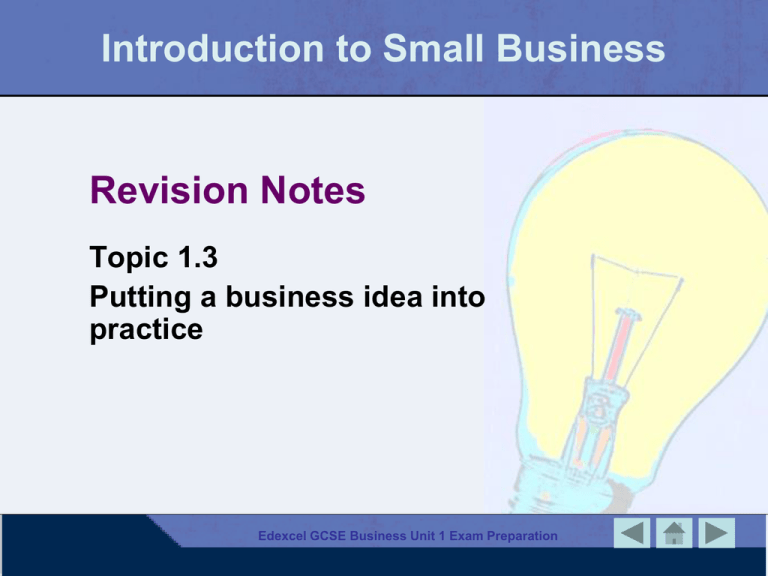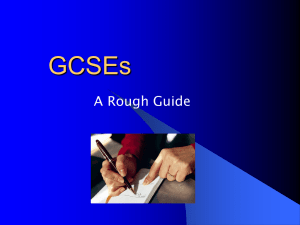Topic 1.3 Putting a business idea into practice
advertisement

Introduction to Small Business Revision Notes Topic 1.3 Putting a business idea into practice Edexcel GCSE Business Unit 1 Exam Preparation Objectives when starting up Financial objectives – targets expressed in money terms, such as making a profit, earning income or building wealth. Non-financial objectives – aims other than financial, why an individual runs their own business. Examples include personal satisfaction, challenge and to help others. Entrepreneurs have different objectives when starting a business. For some, financial objectives are key. Non-financial objectives can also be important. Edexcel GCSE Business Unit 1 Exam Preparation Qualities shown by entrepreneurs Entrepreneurs need to demonstrate a wide range of qualities if they are to succeed. You need to know the following qualities and examples of each. Quality Example of this quality being demonstrated: Determination Refusal to give in after poor sales in the first 6 months of the business Willingness to take risks Investing life-savings into the new business idea to ensure finance is available for the start-up. Ability to plan and persuade Convincing a supplier to offer a 10% discount now with the promise of future orders when the business grows. Showing leadership Having the vision to see how the market will develop over the next 2 years. Luck Employing a worker who turns out to be much better than expected. Edexcel GCSE Business Unit 1 Exam Preparation Estimating revenues and costs Revenue – the money a business receives from the sale of its products. It is found by the following formula: No. jobs done Price per job Total revenue 10 £100 £1,000 Total Revenue = Price x Quantity Sold TR = P x Q 20 £100 £2,000 30 £100 £3,000 40 £100 £4,000 Look at the table (right) and make sure you can see how the revenue figures are arrived at. Edexcel GCSE Business Unit 1 Exam Preparation Costs: fixed and variable Fixed costs • Those costs which do not vary as the level of output changes. • Rent • Advertising • Business rates • Insurance • Salaries Variable costs • Those costs which change as the level of output changes. • Raw materials • Packaging • Wages linked to production Edexcel GCSE Business Unit 1 Exam Preparation Price and Cost Important – price and cost are not the same thing! Make sure you understand the difference. . • Price – the amount paid by the customer who buys the product. In this case, the cost to the customer is the same as the price. • Cost – refers to the cost of production. In other words, how much a product costs to make. A subtle difference, but one you need to be aware of. Edexcel GCSE Business Unit 1 Exam Preparation Calculating profit – or loss Profit occurs when the revenues of a business are greater than its costs over time. When the revenues of a business are less than its costs over a period of time, a loss has occurred. Profit (or loss) is found by the following formula: Profit (or loss) = Total Revenue – Total Costs Look at the table (below) and make sure you can see how the revenue figures are arrived at. Revenue Total costs Profit (or loss) £10 000 £8 000 £2 000 £25 000 £15 000 £10 000 £31 000 £35 000 -£4 000 Edexcel GCSE Business Unit 1 Exam Preparation The impact of profits/losses on business Possible impact of profits on a business and its owners • Survival of the business. • Expansion of the business. • Further investment. • Financial security for the owners (but depends on the size of the profit). Possible impact of losses on a business and its owners • Insolvency – cannot pay bills, suppliers. • Changes to the product or business strategy. • Need for additional finance. • Cost-cutting – cheaper suppliers? Cheaper premises? Edexcel GCSE Business Unit 1 Exam Preparation What is cash flow? Terms you need to know: • • • • Cash flow – the flow of cash into and out of a business. Inflow – the cash flowing into a business (receipts). Outflow – the cash flowing out of a business (payments). Net cash flow – the receipts of a business minus its payments. • Cumulative cash flow – the sum of cash that flows into a business over time. • Insolvency – when a business cannot pay debts. Edexcel GCSE Business Unit 1 Exam Preparation What affects cash flow? The specification makes clear that you need to know how cash flows are affected by stock levels and credit terms. Impact of stock levels on cash flow Impact of credit terms on cash flow • Greater spending on stock leads to greater cash outflow. • Net cash flow position deteriorates. • This may be temporary until the stock is sold. • Improved credit terms by suppliers means less. cash outflow in the short term. • Improved net cash flow position in the short term. Edexcel GCSE Business Unit 1 Exam Preparation Why is cash flow important? Important Cash is not the same as profit! • A business cannot survive without cash. • If a business has more cash flowing out than coming in over a period of time then it cannot pay suppliers and workers. Production will stop. • The business would become insolvent. Cash inflow (revenue) DANGER Cash outflow (costs) Edexcel GCSE Business Unit 1 Exam Preparation What is in the business plan? A business plan is one for the development of a business which gives forecasts of items such as sales, costs and cash. It can also include: Suppliers Marketing methods Personnel Production methods Business premises Sources of finance Type of product Business name Edexcel GCSE Business Unit 1 Exam Preparation Obtaining finance Revision tip You need to understand the difference between long-term and shortterm sources of finance, and which is most appropriate in different circumstances. Entrepreneurs need to raise money (finance) to get started and run their own business. Finance will be needed for a range of purposes. For example: - Wages for staff - Utility bills such as electricity, water and gas - Rent of premises - Stock and other supplies. Edexcel GCSE Business Unit 1 Exam Preparation Short-term finance Short-term sources of finance • Sources of money for business that are borrowed or invested typically for more than a year. You need to know the following: • Overdraft – borrowing money from a bank by drawing more money than is actually in a current account. High rates of interest can be charged for this facility. • Trade credit – where a supplier allows a period of time before the business needs to pay for any supplies received. This can help the cash flow position of a business. Edexcel GCSE Business Unit 1 Exam Preparation Long-term finance Long-term sources of finance • Sources of money for business that are borrowed or invested typically for more than a year. • Personal savings – money set aside and not spent by individuals. • Loans – borrowing which has to be repaid with interest over a period of time. • Retained profit – profit which is kept back in the business and used to pay for investment in the business. • Venture capital – money invested in the business by an individual who hopes to sell their shares to make a profit . • Share capital – the value of a company owned by shareholders. These receive any profits in the form of dividends. Edexcel GCSE Business Unit 1 Exam Preparation






